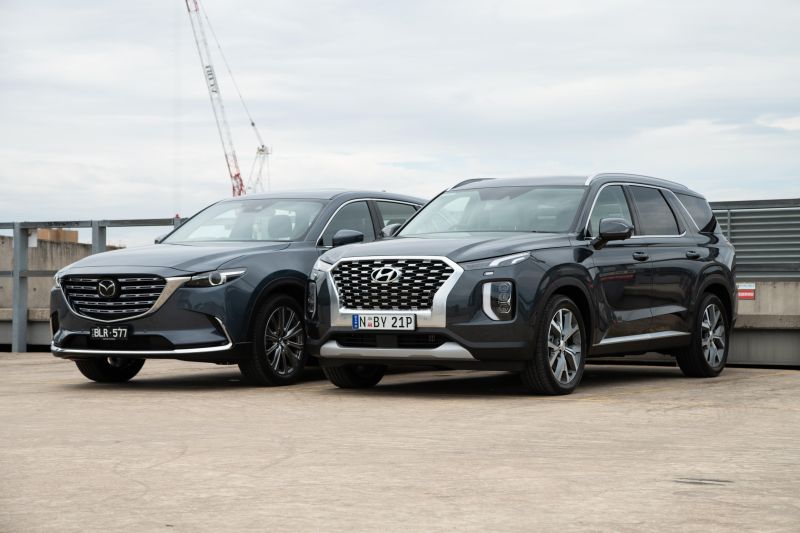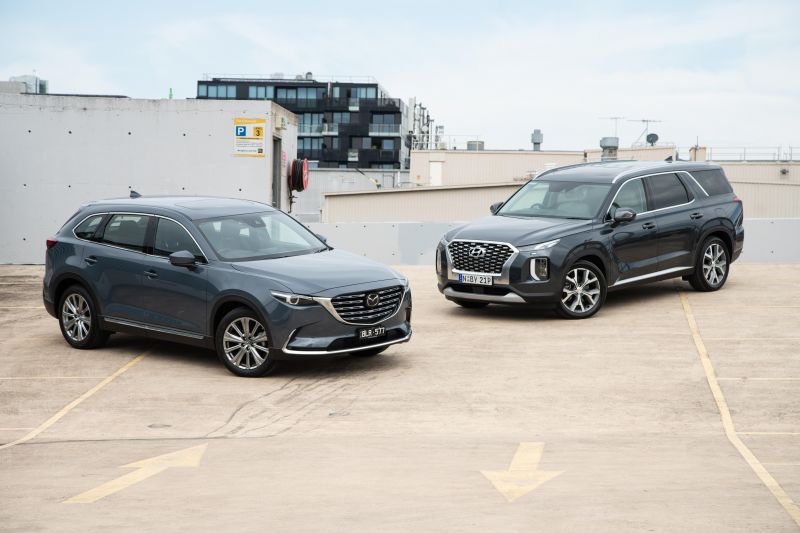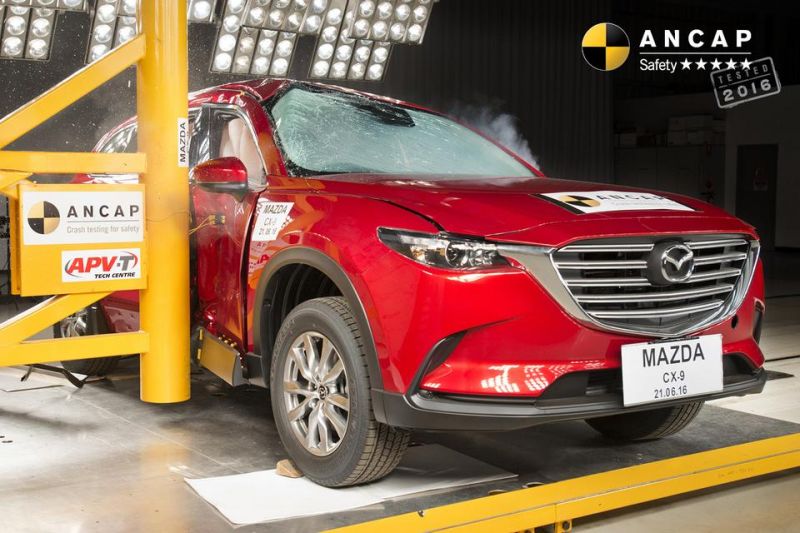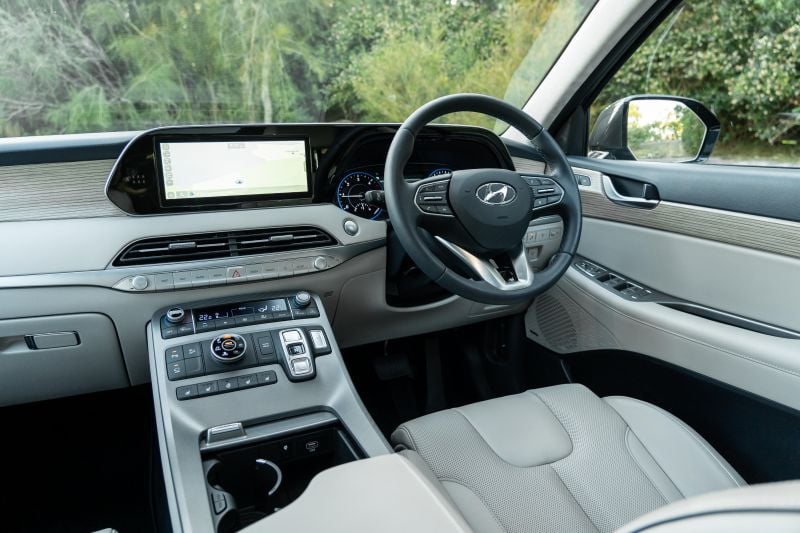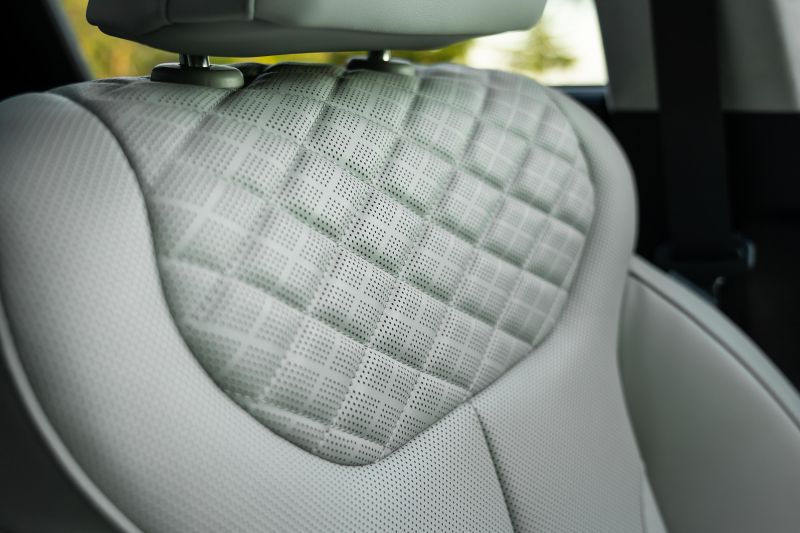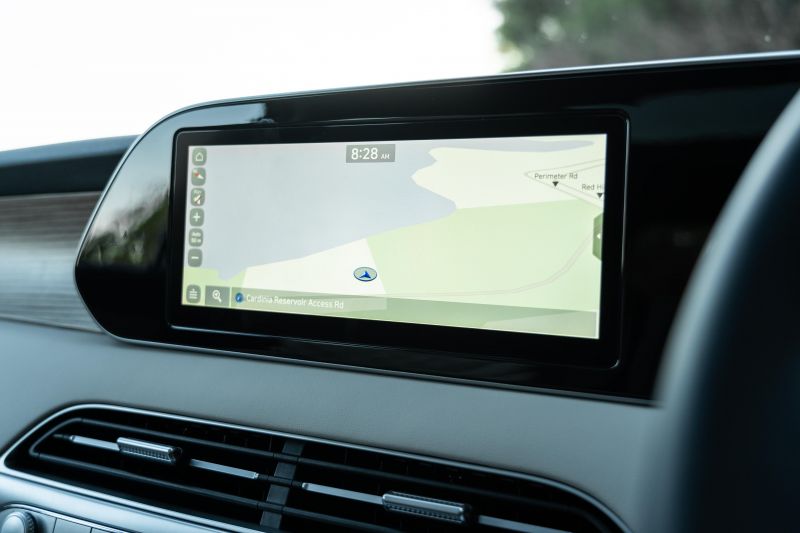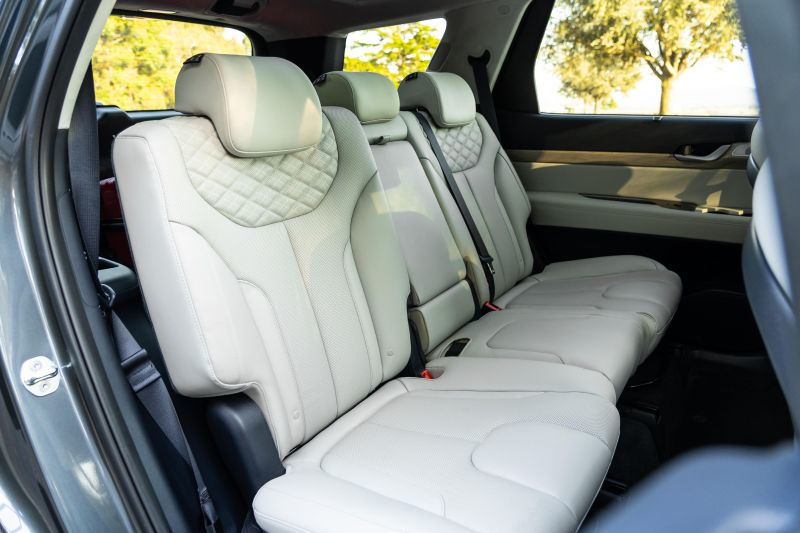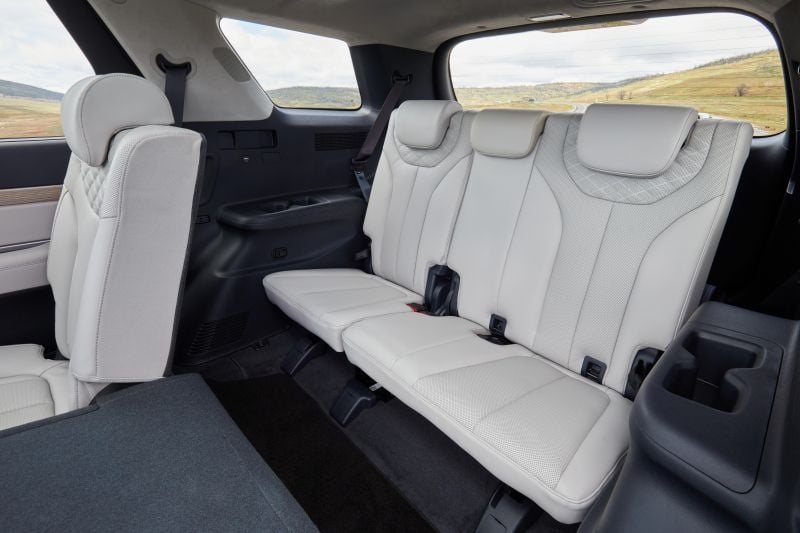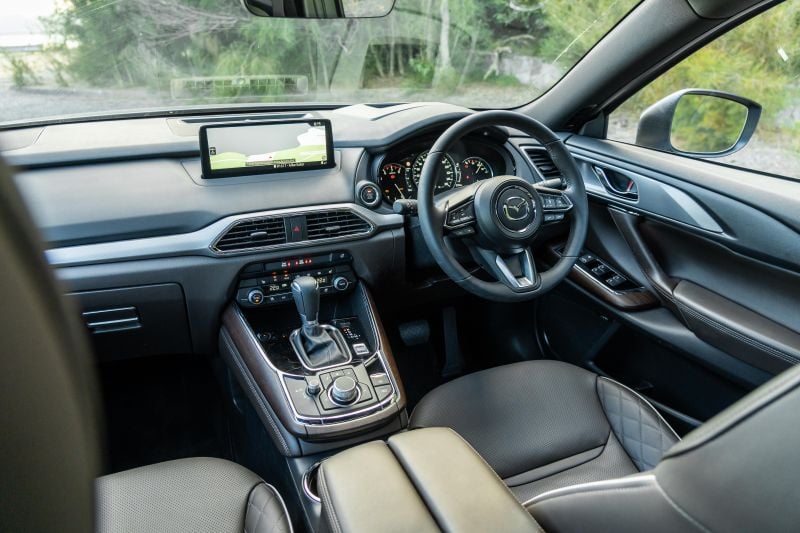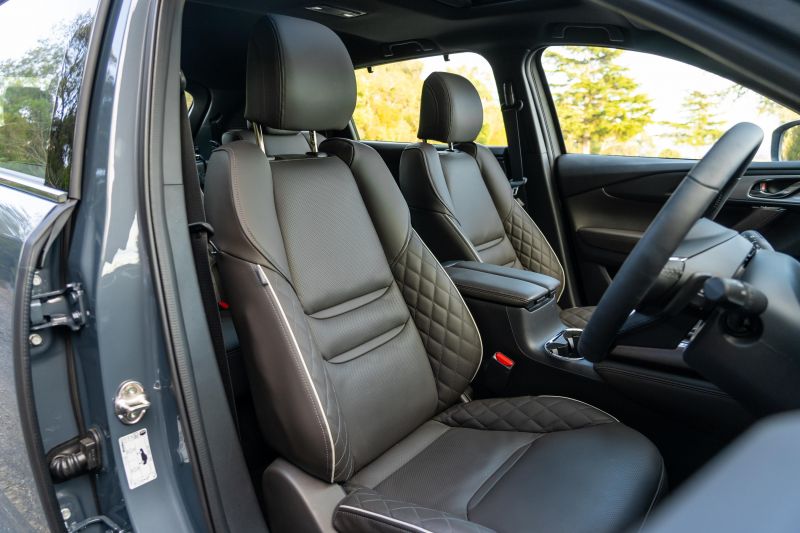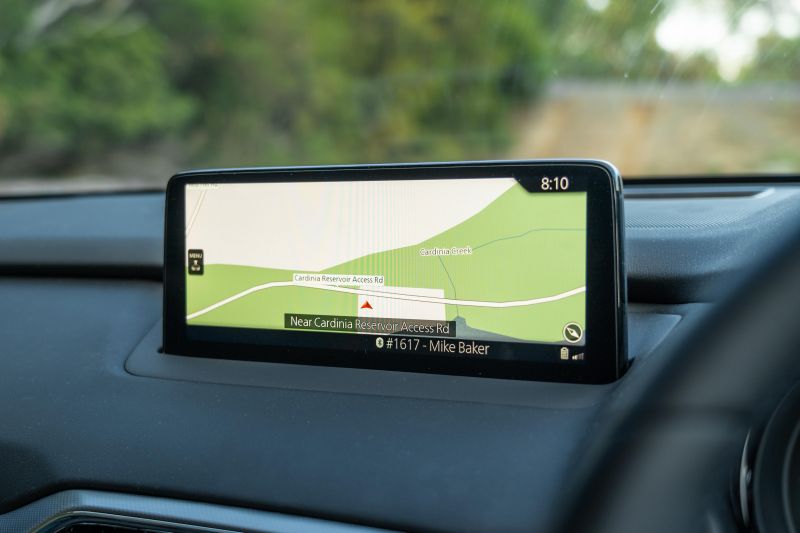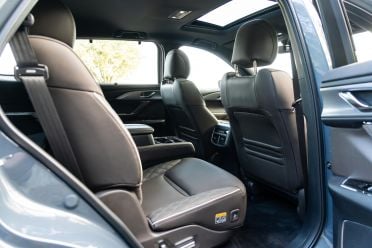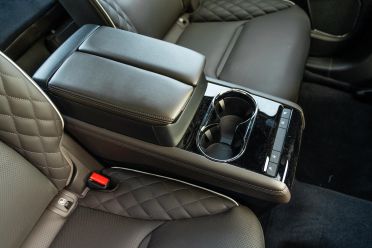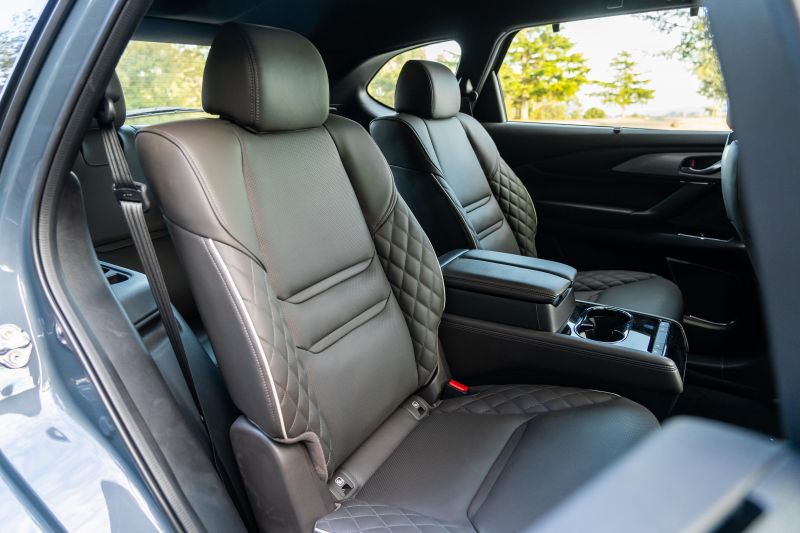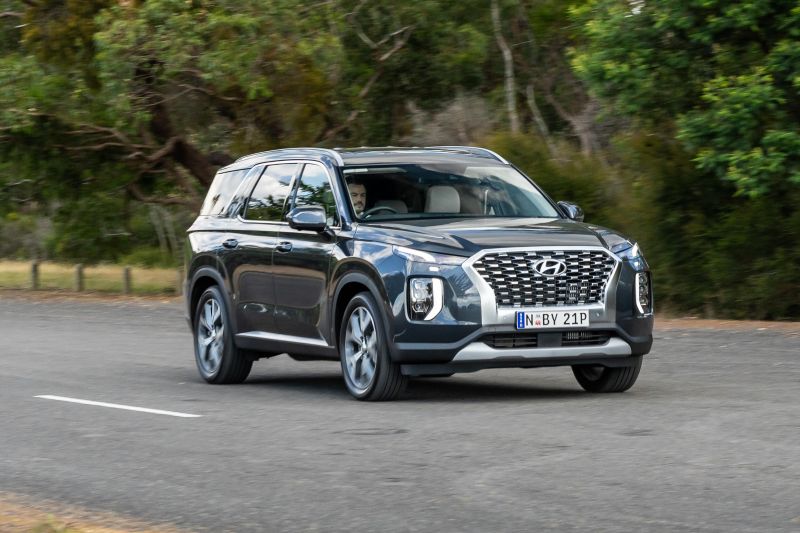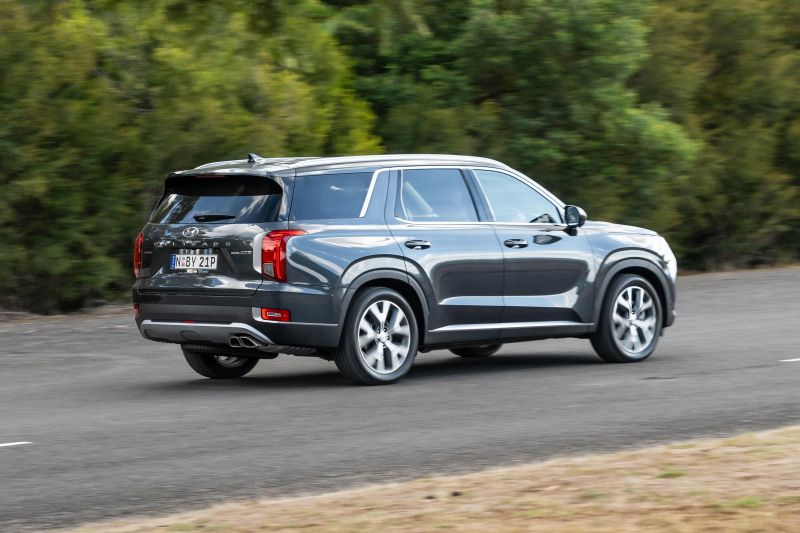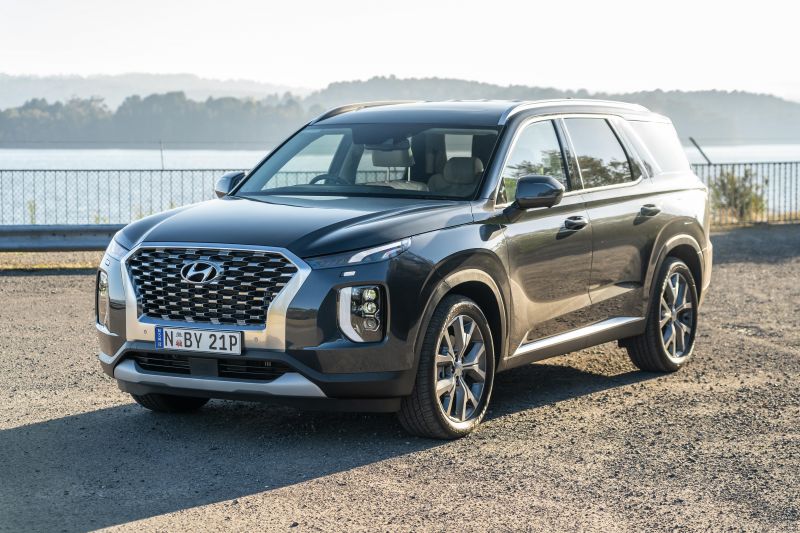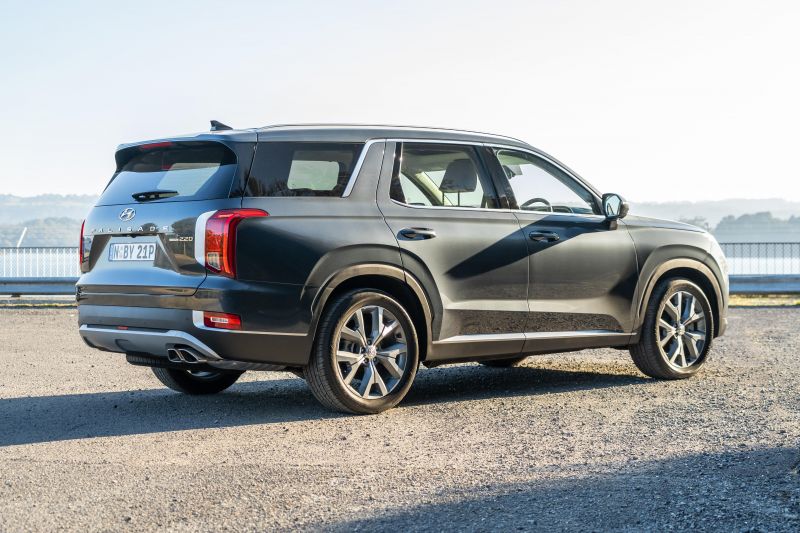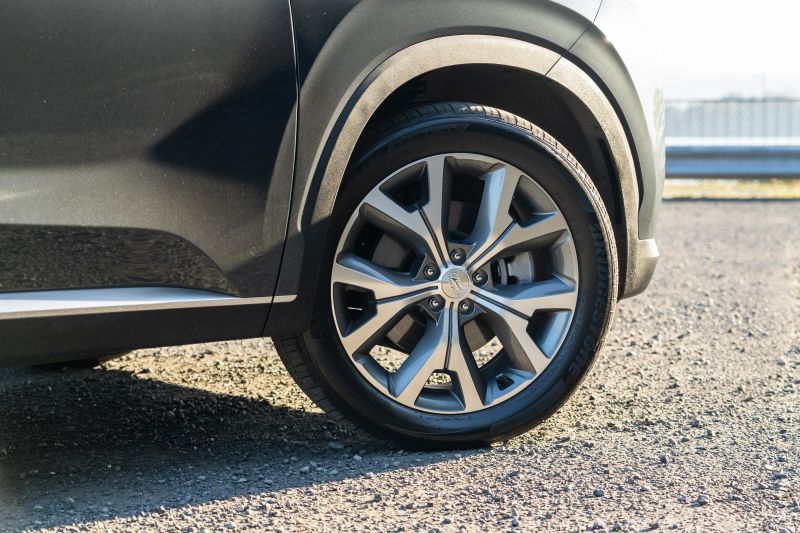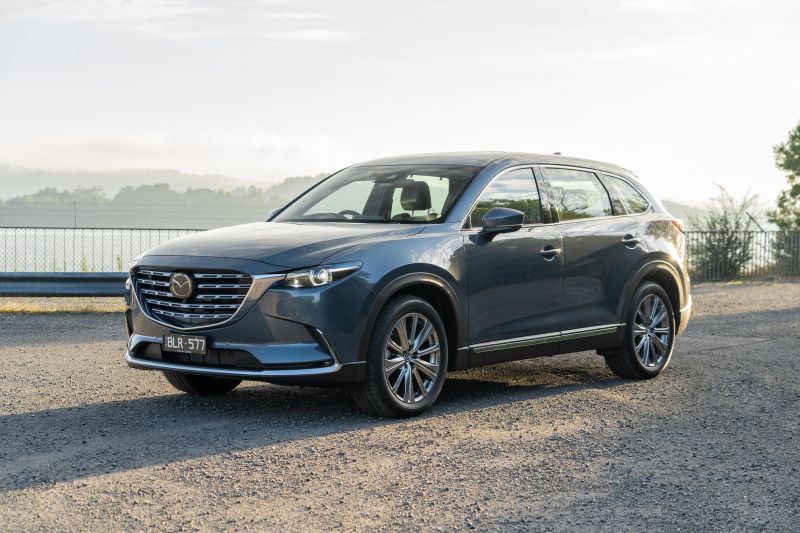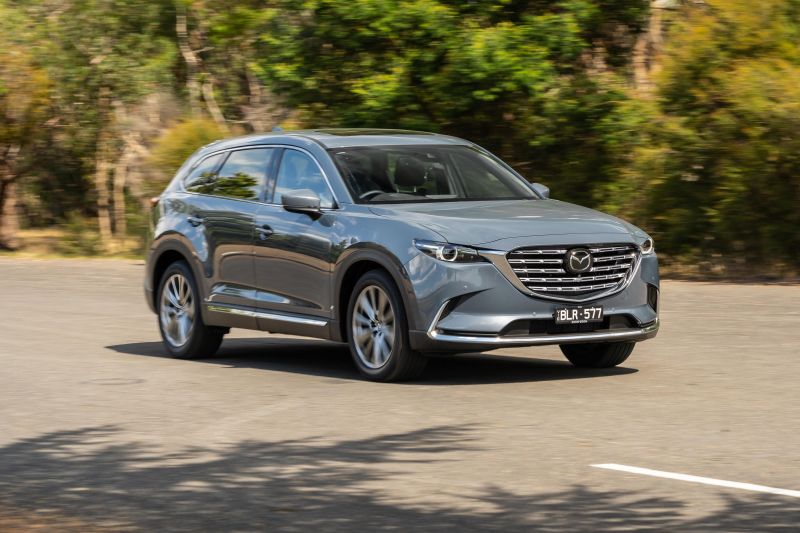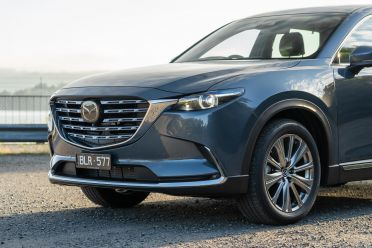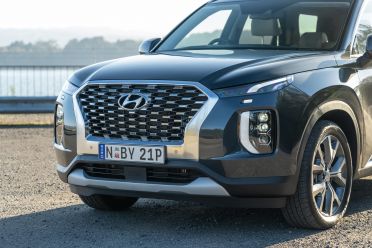If you want to carry a lot of people in style and comfort, Hyundai and Mazda have new options for you.
In the Korean corner is the new Hyundai Palisade Highlander AWD.
It’s the most expensive Hyundai you can buy in Australia, and swaggers into battle with the promise of an expansive interior, a long list of standard features, and an exterior that will make sure you get noticed in the school carpark.
Fighting for Japan is the Mazda CX-9 Azami LE.
The CX-9 isn’t new to Australia like the Hyundai, nor does it have the same in-your-face presence from the outside.
What it does offer, though, is a plush six-seat interior with captain’s chairs for second-row passengers, high-end touches such as wood trim, and a new screen atop the dashboard.
Which of these high-spec haulers is the better bet for big families?
How much?
Both these cars are the most expensive options in their respective ranges, the plushest of the plush.
The Mazda is the slightly cheaper option of the two, with a list price of $73,875 before on-road costs in range-topping Azami LE guise.
The Hyundai has a list price of $75,000 before on-roads in Highlander guise with a turbo-diesel engine and all-wheel drive.
Mazda has a far broader range than Hyundai if you’re after a supersized family hauler. The CX-9 Sport FWD is priced from $45,990 before on-roads, while you can get into a highly-specced Azami AWD for $70,625 before on-roads.
Hyundai has a two-trim, two-engine Palisade range that kicks off at $60,000 before on-road costs for the petrol, front-drive entry level model.
The range-topping Palisade Highlander is priced from $71,000 before on-roads with front-wheel drive and a petrol V6 engine.
| Hyundai Palisade Highlander | Mazda CX-9 Azami LE | |
|---|---|---|
| List price | $75,000 | $73,875 |
| Drive-away price | $77,830 | $76,985 |
Drive-away prices are calculated for a Melbourne postcode using the manufacturer websites.
What do you get?
Hyundai
The Palisade is available with a choice of eight- or seven-seats across the range, and the 10.25-inch touchscreen infotainment system is standard with Android Auto, Apple CarPlay, and factory satellite navigation.
There are LED daytime running lights, tri-zone climate control, keyless entry and start, a powered driver’s seat, and an auto-dimming rear-view mirror, along with a 7.0-inch display between the dials.
Stepping up to the Highlander on test here gets you 20-inch alloy wheels, bi-LED headlights, a powered tailgate, a dual sunroof, and sun blinds on the rear doors.
The seats are trimmed in Nappa leather finished in beige or burgundy, and the headliner is suede.
The front seats are heated and cooled, while outboard second row seats are heated as well. When you opt for the the seven-seat option with captain’s chairs, those second row seats are also cooled.
Mazda
Unlike in the Palisade, the 10.25-inch infotainment screen in the Azami LE isn’t standard across the range.
It’s only offered on the mid-spec CX-9 GT and above, along with niceties such as wireless phone charging, a hands-free powered tailgate, a power tilt and slide sunroof up front, leather seats, and a 12-speaker Bose sound system.
Jumping to the Azami brings adaptive LED headlights, a 7.0-inch display in the instrument binnacle, a heated steering wheel, ventilated front seats, a surround-view camera, real wood trim, and quilted leather trim in brown or white.
The Azami LE, a new addition to the range for 2021, gains powered, heated, and ventilated captain’s chairs in the second row, with a unique console between them.
| Palisade | CX-9 | |
|---|---|---|
| Wheels | 20-inch alloy | 20-inch alloy |
| Headlights | LED | LED |
| Sunroof | Front, fixed rear | Front |
| Proximity key | Yes | Yes |
| Seats | Eight (2+3+3) | Six (2+2+2) |
| Front seat function | Heated, cooled, powered | Heated, cooled, powered |
| Rear seat function | Heated | Heated, cooled, powered |
| Steering wheel heat | Yes | Yes |
| Screen | 10.25-inch (touch) | 10.25-inch |
| Navigation | Yes | Yes |
| Apple CarPlay | Wired | Wired |
| Android Auto | Wired | Wired |
| DAB+ | Yes | Yes |
| Air conditioning | Three-zone | Three-zone |
Are they safe?
Both of these cars come with a full suite of safety systems, both active and passive, but only the CX-9 has a five-star rating from ANCAP.
When the CX-9 was tested in 2016 it received an overall score of 35.87 out of 37.
The Palisade hasn’t been crash tested, and Hyundai has indicated it won’t be supplying a car to ANCAP.
Both cars get front, front-side, and curtain airbags, along with the following active safety assists:
- Driver attention monitoring
- Lane-keeping assist
- Blind-spot monitoring
- Rear cross-traffic alert
- Adaptive cruise control with stop/go
- Trailer Stability Assist
- Front and rear parking sensors
- Reversing camera
The Palisade also features a blind-spot view camera that shows a camera feed of the car’s blind-spot when changing lanes, along with blind-spot and rear cross-traffic assist systems which will brake instead of simply warning the driver if they detect an impending collision.
What are they like inside?
Hyundai
If the exterior left you in any doubt the Palisade was aimed at North America, the interior will really ram the point home.
The Palisade feels utterly massive inside in a way the Mazda doesn’t, no doubt in an attempt to win the hearts and minds of buyers raised on a steady diet of Chevy Tahoes and Ford Expeditions.
Where Mazda has chased a smoking lounge vibe, the front of the Palisade’s cabin seems to take its inspiration from the flight deck of a passenger airliner.
There’s a broad, clean transmission tunnel flowing up to the dashboard, upon which are scattered big, chunky buttons for everything from the transmission to the heated seats, climate control, and drive mode.
Subtle? Not really, but it’s dead easy to navigate. If you’re running late for school with four kids screaming at you from the back seat that’s probably a good thing.
The driver and passenger sit in supremely comfortable seats that offer excellent under-thigh support and a broad range of adjustment for taller drivers, and the relationship between the pedals, wheel, and seat is near perfect.
They’re trimmed in supple Nappa leather in the Highlander, and like in the Mazda are heated and cooled. The chunky steering wheel is also heated, and feels nice in the hand.
Although the CX-9 isn’t bad from behind the wheel, the Palisade is more comfortable if you’re spending long hours on the open road.
It’s also more practical, with a gargantuan storage bin atop the transmission tunnel with hide-away cupholders and a wireless phone charger, a massive central storage bin, and a space below the bridge-style transmission tunnel for a handbag.
Sure, it can’t match the Mazda for luxury-like finishes, but the Palisade feels far from cheap.
The trim on the transmission tunnel feels cold to the touch, and the two-tone interior finish combines with a suede headliner to deliver the sort of ambience you’d expect of a $75,000 car.
Hyundai’s latest 10.25-inch infotainment system is a known quantity by now, having featured in everything from the new Kona to the Kia Sorento.
It’s quick to respond, has handy shortcut buttons along its base, and packs all the features you’d expect, but it takes time to get familiar with the menu structure.
The fact the back, home, and menu shortcuts are hidden at the top-left corner of the display won’t win favour with shorter drivers, either.
All told there are seven USB ports and 16 cupholders, enough to keep the whole cabin charged and hydrated on long trips.
There’s also a neat function allowing the driver to broadcast to the rear seats like an airline captain, in case people in the back row are having trouble hearing… or if the kids are trying to ignore mum and dad.
Speaking of those rear seats, our Palisade was an eight-seater with three-seat benches in both the second and third rows. Mazda-style Captain’s Chairs are a no-cost option in the Highlander, but you don’t get a ‘console’ between them.
Instead, rear passengers can walk through the middle of the car. Hyundai says parents with two child seats prefer this setup, because the seats can be mounted in the middle row without impeding access to the three-seat third-row bench.
It’s less luxurious than the business class setup in the Mazda, but arguably more usable for the average family.
Rear legroom is capacious behind tall drivers, and headroom is accomodating for even the tallest of hairstyles.
Access to the third row in the Palisade is easier than in the CX-9, with seats that electrically tilt and slide forward. Once you’re back there, the Palisade is arguably the best people-moving SUV on the market for carrying seven or eight people.
It’s still not a match for the Kia Carnival back there, but you can fit small adults or older kids for long trips without too much stress. There are air vents, temperature controls, and USB ports back there.
Boot space is 311L with all three rows of seating in place, and 711L with the third row folded.
Mazda
The Hyundai is all about light colours and big, chunky buttons.
Mazda takes a distinctly different approach, with lots of dark materials and old-fashioned luxury touches.
It’s trimmed like a smoking lounge, with dark brown quilted leather trim on the seats and real wood highlights on the door trims and around the transmission tunnel.
The aluminium trim on the dashboard is real, and has a novel pattern etched into it, and the steering wheel trim feels soft and waxy in your hands.
The Azami LE shares its bones with a $45,000 base model, but real effort has clearly gone into making it feel plush.
Although they look great and pack heating/ventilation, the front seats in the CX-9 are less supportive than the La-Z-Boy recliners in the Palisade. Their bases are too short, and can’t be canted backwards to provide under-thigh support for longer-legged drivers.
At six-seven I’m not exactly average height, but my shorter colleagues suffered the same problem so it’s not all down to genetics.
Flat bases aside the driving position is pretty good, and doesn’t get tiresome on long trips.
There’s an abundance of storage spots around the cabin, but the CX-9 doesn’t have as much space for odds and ends as the Palisade with its pair of capacious cutout spaces in the transmission tunnel.
The wireless phone charger in the CX-9 is harder to access, although it doubles as a well-hidden spot for your wallet or keys if you don’t need to juice up.
Mazda has made a huge leap forward in the technology department, replacing its laggy infotainment and small screen with the system from the latest Mazda 3.
The 10.25-inch system in the new model is a huge step forward. The graphics are sharper, the responses are faster, and the overall aesthetic of the system is hugely improved.
Apple CarPlay and Android Auto are both standard, but they can’t be controlled by touch. Instead, the infotainment system in the new CX-9 is rotary controller-only.
Although it doesn’t have the same initial ‘wow factor’ of the Hyundai’s sideboard-sized touchscreen, the muted graphics and simple menus of the CX-9 are easier to navigate on the move.
The second row is where the fun really starts in the Azami LE. Forget a three-seat bench, that’s far too common. Instead, it gets two individual captain’s chairs with heating and cooling, along with their own centre console.
They’re even powered. This is proper business class stuff. Like in the seven-seat model, there are air vents and USB ports back there as well.
They aren’t perfect, though. The seats fold to allow access to the third row, but the console doesn’t move. That means you can’t walk through the middle, which you can do in the seven-seat Palisade.
Legroom is good, but not quite Palisade good. There’s more than enough space for adults sitting behind adults, but not quite as much as you get in the Hyundai.
The other downside is that the CX-9 Azami LE is a six-seater, rather than a seven-seater. Other CX-9 grades come with seven seats, remember.
The three-seat rear bench in the Palisade means opting for captain’s chairs drops capacity from eight to seven, which makes life easier if it’s your turn to lug the football team around.
As for the third row? Passengers get USB ports and air vents, but the CX-9 can’t match the Palisade for legroom, nor is the bench as broad.
With the third row in place, the CX-9 offers 230L of cargo capacity, expanding to 820L with it folded.
Under the boot floor is a space-saver spare wheel.
| Palisade | CX-9 | |
|---|---|---|
| Length | 4980mm | 5075mm |
| Width | 1975mm | 1969mm |
| Height | 1750mm | 1747mm |
| Wheelbase | 2900mm | 2930mm |
What’s under the bonnet?
Hyundai
Although the Palisade is available with a 3.8-litre petrol V6 engine and front-wheel drive, our tester was instead fitted with a 2.2-litre turbo-diesel four-cylinder engine.
It pumps out 147kW of power and 440Nm of torque, mated with an eight-speed automatic and all-wheel drive.
Although that’s down 70kW on the petrol option, the diesel has 85Nm more torque.
Claimed fuel economy is 7.3L/100km on the combined cycle.
Mazda
Want diesel power? You’ll need to look at the Mazda CX-8, because the CX-9 is petrol only. Blame the North American market, which is vehemently anti-oiler.
Power across the Mazda CX-9 range comes from a 2.5-litre turbocharged petrol engine, mated with a six-speed automatic transmission and on-demand all-wheel drive.
Peak power is 170kW at 5000rpm, and peak torque is 420Nm at 2000rpm.
Front-wheel drive is available in lower-spec models, but the Azami LE is all-wheel drive only.
Claimed fuel economy is 9.0L/100km on the combined cycle.
| Palisade | CX-9 | |
|---|---|---|
| Fuel | Diesel | Petrol |
| Displacement | 2.2-litre | 2.5-litre |
| Induction | Turbo | Turbo |
| Power | 147kW | 170kW |
| Torque | 440Nm | 420Nm |
| Transmission | Eight-speed auto | Six-speed auto |
| Drive | All-wheel | All-wheel |
| Economy | 7.3L/100km | 9.0L/100km |
| Fuel tank | 71L | 74L |
| Braked towing | 2200kg | 2000kg |
How do they drive?
Hyundai
The Palisade might look like a truck, but it doesn’t drive like one.
Light, quick (well, relatively) steering and excellent all-round visibility mean it doesn’t feel out of place in tighter city streets or underground garages.
The surround-view camera is crisp, and an array of parking sensors and cross-traffic alerts leaves no excuse for scrapes and scratches.
Also handy is the blind-spot camera, which plays a live feed from under your mirror when the indicator is activated.
Along with the conventional blind-spot warning light and mirrors, it makes it easier to change lanes when there are bikes around.
Up the speed and the Palisade has a lovely, languid character. There’s no sporting pretence here; it’s a family bus designed to haul eight people around in comfort.
That means the suspension initially feels quite soft compared to the CX-9.
It does an impressive job keeping the car’s big frame in check, and the bigger wheels on the Highlander don’t seem to undermine its ride quality on rough, patchy back roads.
There’s no big-car float over crests, although the suspension can be a bit noisy when confronted with potholes and sharper lumps and bumps.
Road noise is well contained on smooth highways, but the Palisade is louder in than the CX-9 when you hit coarse chip country highways.
It’s far from a deal-breaker, but you’ll need to turn up the stereo a few extra notches to drown it out.
Although there is a front-wheel drive petrol option, the 2.2-litre diesel is the pick of the range.
That’s partly because it’s all-wheel drive, fixing the base model’s propensity for wheel spin if you’re in a bit of a hurry, and partly because it’s a more relaxed way to haul around two tonnes worth of family SUV.
With 440Nm of torque available between 1750 and 2750rpm it feels sprightly off the mark, and the eight-speed automatic transmission does a good job keeping it in its power band when you need to get a move on.
It never feels fast, but there’s sufficient performance on offer.
Loaded up with eight people and luggage? You’ll need to work it harder, but the low-down torque and smart transmission mean the diesel Palisade should be able to get the job done without having to weld the accelerator to the firewall.
Although there’s a slightly gruff diesel rumble when you really lean on it, it’s a silent partner at highway speeds.
A typically Hyundai quirk detracts from what’s otherwise a well-sorted family hauler. The lane-centring system is far too grabby, and tries to impart its will on the driver when it’s really not necessary.
Unlike the rest of Hyundai’s new products, the button to turn it off is hidden next to the parking brake by the driver’s right knee.
It also needs to be switched off whenever you hop into the car.
Mazda
The CX-9 immediately feels more substantial on the road than the Palisade.
The steering has more weight to it, and the ride is tauter over smaller city lumps and bumps.
It’s not what you’d call firm, but the driver and passengers are more aware of potholes and speed bumps than they are in the Palisade. The CX-9 is far from uncomfortable, but it doesn’t quite float over imperfections like its Korean rival.
Like the Palisade, the CX-9 hides its bulk well in the city. Visibility is good all around, although not quite as good as in the boxier Hyundai, and the full range of cameras, sensors, and alerts is present.
The CX-9 doesn’t have a blind-spot view camera, however, and its surround-view camera resolution is grainier than it really should be in 2021.
Refinement is at the core of the Mazda’s appeal. Wind and road noise are barely heard in the cabin at highway speeds, even when you hit coarse chip gravel, and the 2.5-litre petrol engine is a smooth operator.
It’s down slightly on torque compared to the turbo-diesel engine in the Palisade, but you wouldn’t know it day-to-day. There’s just a hint of turbo lag off the mark, but once the turbocharger is singing it feels rapid for such a big car.
With 33kW more than the Hyundai, and peak power coming on song at 5000rpm, it also pulls harder through the rev range when you’re in a hurry.
There’s no diesel clatter, and the way it delivers its performance is just… nicer than the torque-rich, power-light engine in the Palisade.
It’s also thirstier than the diesel in the Palisade, but that’s to be expected.
Body control in the Mazda is relatively taut for such a big bus which, combined with heavier steering than the Hyundai, makes it feel seriously planted on the highway.
The driver aids in the CX-9 are also better tuned than those in the Palisade, with a gentler touch from the lane-keeping assist.
Cost of ownership
Hyundai
The Palisade is covered by Hyundai Australia’s five-year, unlimited-kilometre warranty with roadside assistance for the same period.
It’s also backed by lifetime capped-price servicing. Maintenance is required every 12 months or 15,000 kilometres.
The first five services in the 2.2-litre diesel each cost $469, totalling $2345 for the first 60 months.
Mazda
The CX-9 is covered by Mazda Australia’s five-year, unlimited-kilometre warranty with roadside assistance for the same period.
Servicing is required every 12 months or 10,000 kilometres, meaning drivers who cover a lot of distance will be at the dealer more frequently.
The first five visits will cost $363, $408, $363, $408 and $363 respectively, totalling $1905 for the first 60 months.
CarExpert’s Pick
The Mazda CX-9 is a nicer, more luxurious car than the Palisade, but it isn’t a better one.
If outright practicality isn’t your number one priority it’s a winner, but it isn’t the winner of this comparison.
It’s slightly more expensive than the CX-9, but the Palisade Highlander is a better family car.
The big Hyundai is more spacious in both the second and third rows, and is more comfortable for the driver on long trips.
It’s not quite as fun to drive, but driving fun isn’t really the goal here.
If lugging lots of people and luggage in style is the goal, the Palisade could just be the answer.





